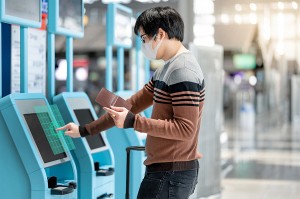Bristol-based Ultraleap has launched a new tool that harnesses its pioneering touchless technology to eliminate the need for people to touch interactive screens to buy tickets and other products in places such as railway stations, hotels and airports.
With the majority of people anxious about touching screens due to Covid-19, TouchFree is designed to run on top of existing user interfaces without the need for design modification. 
It detects a user’s hand in mid-air and converts it into an on-screen cursor, meaning that users find the interaction familiar as it mimics the way we use touchscreens.
According to recent research conducted by Ultraleap, 80% of people now think public touchscreens are unhygienic while the coronavirus pandemic continues.
Yet many restaurants, train stations, hotels, museums and airports rely heavily on public touchscreens and kiosks to help reduce transaction time, enhance shopping experiences and handle higher volumes.
Ultraleap has collaborated with 20-plus global kiosk makers, brands and agencies to perfect the application and make it real-world ready.
Originally called Ultrahaptics – and a spin-out from the University of Bristol which combined with US firm Leap Motion two years ago – Ultraleap has developed the world’s most advanced hand tracking technology.
Strong growth over recent years means the company now employs more than 150 people across the UK, US and Asia.
Ultraleap recently signed a deal with Cortina Productions, an award-winning US experience design company, to use its touchless technology in interactive exhibits in museums and aquariums.
The technology will allow visitors to control interactive content without touching public surfaces or buttons, eliminating concerns about Covid-19 transmission.
Cortina is among the first firms to deploy TouchFree, which uses Ultraleap’s camera module and hand-tracking software and can be seamlessly retrofitted to existing kiosks and touchscreens, moving consumer interactions with public screens into mid-air.
The system provides touchscreen emulation by detecting a user’s hand in mid-air, converting it to an on-screen cursor, and supporting interaction methods that users are familiar with.
TouchFree is designed to run invisibly on top of existing user interfaces without the need for modifications to existing interfaces and design, means downtime to retrofit is kept minimal, interactions remain familiar, and the system continues to be easy for consumers to use.
Ultraleap CEO Steve Cliffe said: “Conventional touchscreens have worked well over the years because of their convenience, but people want to be able to interact with them in ways they perceive to be safe.
“Our recent research showed that just 50% of consumers were likely to use touchscreens again. TouchFree is the ideal application to retrofit existing touchscreen-based kiosks for businesses looking to encourage users back, maximise user interaction and ensure customers feel safe.”
Cortina principal and director of development Jim Cortina added: “We’ve received many requests from our museum clients to turn their touchscreen exhibits into touchless experiences – and fast. TouchFree gives us a viable and customizable solution to interact in a safe and engaging way.”
In February Ultraleap secured a deal with US electronic media giant CEN to use its technology in interactive cinema lobby advertising – so allowing brands to continue to engage with audiences while supplying vital revenue to movie theatre operators.






























